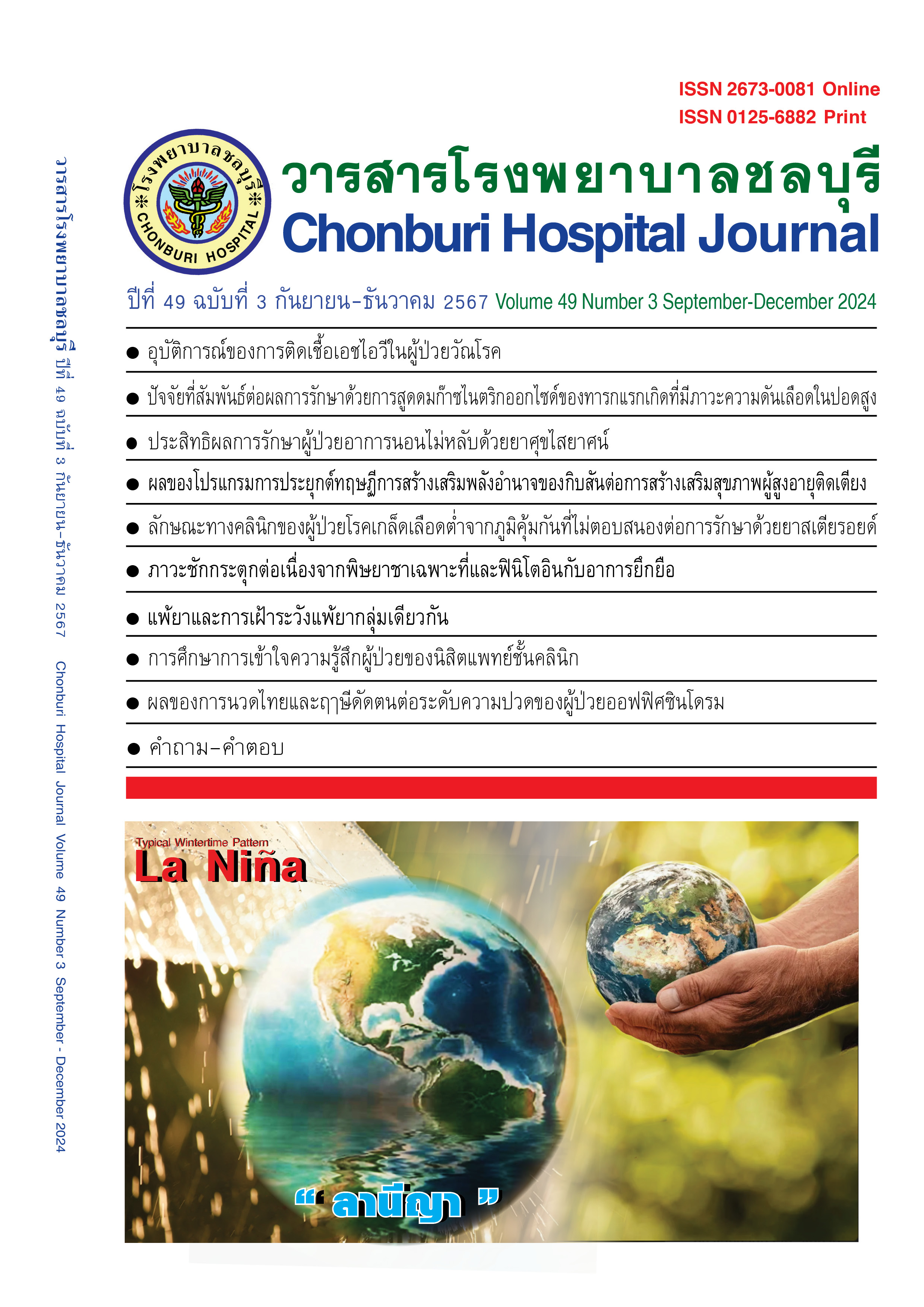The Efficiency of the “Suksaiyas” Medicine Formula on Insomnia Patients.
Abstract
Insomnia is a common health issue that affects the quality of life, leading to cardiovascular diseases and increasing the risk of depression. Pre-Experimental Research is a one-group experimental study aimed at studying the effectiveness of the treatment of patients with insomnia and adverse reactions to the treatment. The sample group consists of patients with insomnia from the integrated medical cannabis clinic at Chonburi Hospital. A total of twenty-five people. The researchers collected sleep quality data from April 2023 to February 2024 using general information about the research participants, depression assessment (9Q), the Thai version of the Pittsburgh Sleep Quality Index, the Suanprung Stress Test, Adverse drug reaction and Laboratory blood tests. Analyze the data using descriptive statistics and sleep quality analysis with a paired t-test and repeated measure ANOVA, setting the statistical significance level at a P-value less than 0.05. This study, it was found that patients with insomnia had an average sleep quality score (Thai-PSQI score) before and after treatment with the “Suk Sai-Yad” formula. The average Thai-PSQI scores before treatment, after 2 weeks of treatment, and after 1 month of treatment were 15.84±1.72, 13.32±4.88, and 8.64±2.80, respectively. Follow-up results after stopping the medication for 1 month showed average Thai-PSQI scores after stopping the medication at weeks 1, 2, and 3 and after stopping the medication for 1 month were 7.32±2.06, 7.44±2.24, 7.48±2.10, and 7.44±2.04, respectively (a Thai-PSQI score of 5 or less indicates good sleep quality). The comparison of sleep quality results showed that the average sleep quality scores were significantly different (p < 0.05). Laboratory blood tests before and after treatment with the “Suk Sai-Yad” formula showed average liver function (AST) values of 27.80±10.99 and 32.92±6.85, respectively, and average liver function (ALT) values of 25.00±15.22 and 34.84±10.49, respectively, which increased significantly (p < 0.05). The average glomerular filtration rate (GFR) before and after treatment was 80.16±12.53 and 81.56±12.12, respectively, with no statistical difference (p > 0.05).
Research findings indicate that patients with insomnia have improved sleep quality. The medication does not make them drowsy more easily but helps them sleep longer, increasing their sleep duration. They do not feel fatigued after waking up, and their quality of life has improved. However, the use of the “Suk Sai-Yad” medicine must be strictly and cautiously indicated, especially in elderly patients, as the herbs in the “Suk Sai-Yad” formula may affect the liver function. Therefore, regular monitoring and liver function tests are necessary, along with further research. These study results are beneficial for the development and continuation of the “Suk Sai-Yad” research. The study procedures can also be used to establish guidelines for integrated medical cannabis assessment and treatment.
Keywords : “Suk Sai-Yad” medicine formula, insomnia, Quality of sleep, Cannabis for Medical
References
Schwartz S, Anderson WM, Cole SR, Cornoni-Huntley J, Hays JC, Blazer D. Insomnia and heart disease: a review of epidemiologic studies. Journal of Psychosomatic Reseaarch 1999;47(4):313-33.
Ford DE, Kamerow DB. Epidemiologic study of sleep disturbances and psychiatric disorders. An opportunity for prevention. Journal of American Medical Association 1989;262(11):1479-84.
Leger D, Guilleminault C, Bader G, Levy E, Paillard M. Medical and socioprofessional impact of insomnia. Sleep 2002;25(6):625-29.
Closs SJ. Sleep. In: Alexander MF, Faweett JN, Runciman PJ, editors. Nursing practice: hospital and home - the adult. Edinburgh: Churchill Livingstone; 1999. p. 743-56.
National Institutes of Health. National Institutes of Health State of the Science Conference statement on Manifestations and Management of Chronic Insomnia in Adults. Sleep 2005;28:1049-57.
American Psychiatric Association. Diagnostic and Statistical Manual of Mental Disorders. 4thed. Text revision. Washington, DC: American Psychiatric Association; 2000.
Bliwise NG. Factors related to sleep quality in healthy elderly women. Psychology and Aging 1992;7(1):83-8.
คัมภีร์ธาตุพระนารายน์ (ฉบับใบลาน). กรมหลวงวงสาฯ กรมหมื่นไชยนาท ประทาน พ.ศ. 2459
ชยันต์ พิเชียรสุนทร, แม้นมาส ชวลิต, วิเชียร จีรวงส์. คำอธิบายตำราพระโอสถพระนารายณ์ ฉบับเฉลิมพระเกียรติ 72 พรรษา มหาราชา 5 ธันวาคม พุทธศักราช 2542. พิมพ์ครั้งที่ 2. กรุงเทพฯ: สำนักพิมพ์อมรินทร์และมูลนิธิภูมิปัญญา; 2548.
ศรายุธ ระดาพงษ์, พราว ศุภจริยาวัตร, เมธิน ผดุงกิจ. ฤทธิ์ทางเภสัชวิทยาและพิษวิทยาของกัญชา. วารสารกรมวิทยาศาสตร์การแพทย์ [อินเทอร์เน็ต]. 2564 [เข้าถึงเมื่อ 22 พฤศจิกายน 2565];63(1):219-32. เข้าถึงได้จาก: https://he02.tci-thaijo.org/index.php/dmsc/article/view/250243/170180
กัมปนาท สุริย์, กุลนิดา สุนันท์ศิริกูล, กิตติยารัตน์ ต้นสุวรรณ. คุณภาพของการนอนหลับและปัจจัยที่เกี่ยวข้องในผู้อายุชุมชนเขตเมืองจังหวัดนครสวรรค์. วารสารวิชาการแพทย์และสาธารณสุข เขตสุขภาพที่ 3 2565;19(1):15-27.
ศศิพงษ์ ทิพย์รัชดาพร. การประเมินประโยชน์และความปลอดภัยจากการใช้ตำรับยาแผนไทยเข้ากัญชา ณ คลินิกหางกระรอก โรงพยาบาลพระอาจารย์ฝั้น อาจาโร : กรณีศึกษาตำรับยาศุขไสยาศน์ [อินเทอร์เน็ต]. 2562. [เข้าถึงเมื่อ 20 พฤศจิกายน 2565]. เข้าถึงได้จาก: http://www.arjarohospital.go.th/index.php?option=com_attachments&task=download&id=434
วิมล สุวรรณเกษาวงษ์, ภควดี ศรีภิรมย์, ปราโมทย์ ตระกูลเพียรกิจ, ชญานิษฐ์ เพ็ชรรัตน์, วรสิทธิ์ ศรศรีวิชัย. การประเมินการใช้ Thai Algorithm สำหรับติดตามอาการไม่พึงประสงค์จากการใช้ยา. วารสารวิชาการสาธารณสุข [อินเทอร์เน็ต]. 2559 [เข้าถึงเมื่อ 20 พฤศจิกายน 2565];25(4):673-82. เข้าถึงได้จาก: https://thaidj.org/index.php/JHS/article/view/345/297
สุรีรัตน์ ณ วิเชียร. การนอนหลับของผู้สูงอายุในชุมชน. วารสารการพยาบาล 2564;36(2):18-31.
Spielman AJ, Saskin P, Thorpy M.J. Treatment of chronic insomnia by restriction of time in bed. Sleep 1987;10:45-56.
Morin CM. Insomnia: psychological assessment and management. New York: Guilford Press; 1993.
ธิติมา ณรงค์ศักดิ์, ฐิติมา สงวนวิชัยกุล, วรพงศ์ ตรีสิทธิวนิช. การนอนหลับและสุขอนามัยการนอนหลับ [บทความฟื้นฟูวิชาการ]. วารสารสถาบันจิตเวชศาสตร์สมเด็จเจ้าพระยา 2563;14(2):69-85.
Hfocus เจาะลึกระบบสุขภาพ. นักวิชาการห่วง! ผลกระทบ “ใบกระท่อม-กัญชา” ส่งผลต่อสมอง ตับ ทางเดินอาหาร [อินเทอร์เน็ต]. 11 สิงหาคม 2566 [เข้าถึงเมื่อ 25 พฤศจิกายน 2566]. เข้าถึงได้จาก: https://www.hfocus.org/content/2023/08/28172
ฐานข้อมูลสมุนไพร คณะเภสัชศาสตร์ มหาวิทยาลัยอุบลราชธานี. การบูร [อินเทอร์เน็ต]. 11 สิงหาคม 2566 [เข้าถึงเมื่อ 25 พฤศจิกายน 2566]. เข้าถึงได้จาก: https://phar.ubu.ac.th/herb- DetailThaicrudedrug/19
ฐานข้อมูลสมุนไพร คณะเภสัชศาสตร์ มหาวิทยาลัยอุบลราชธานี. ลูกจันทน์ [อินเทอร์เน็ต]. 11 สิงหาคม 2566 [เข้าถึงเมื่อ 25 พฤศจิกายน 2566]. เข้าถึงได้จาก: https://phar.ubu.ac.th/herb-DetailThaicrudedrug/121
ศูนย์ข้อมูลสมุนไพร คณะเภสัชศาสตร์ มหาวิทยาลัยมหิดล. สะเดา [อินเทอร์เน็ต]. 11 สิงหาคม 2566 [เข้าถึงเมื่อ 25 พฤศจิกายน 2566]. เข้าถึงได้จาก: https://medplant.mahidol.ac.th/poisonpr/docs/0647.htm
ณัชชา เต็งเติมวงศ์. ประสิทธิผลและความปลอดภัยของตำรับยาสมุนไพรศุขไสยาศน์ในโรคนอนไม่หลับเรื้อรัง : การศึกษาย้อนหลังเบื้องต้นในโรงพยาบาลเจ้าพระยาอภัยภูเบศร. วารสารการแพทย์แผนไทยและการแพทย์ทางเลือก 2564;19(2):331-43.
ศูนย์อำนวยการป้องกันและปราบปรามยาเสพติด กระทรวงสาธารณสุข. คำแนะนำการดูแลรักษาผู้ป่วยที่มีการใช้กัญชาในประเทศไทย. กระทรวงสาธารณสุข. [ม.ป.ป.].
กรมการแพทย์แผนไทยและการแพทย์ทางเลือก. คู่มือการปรุงยาเฉพาะรายตำรับยากัญชาทางการแพทย์แผนไทย (ส่วนที่ไม่เป็นยาเสพติดให้โทษ) สำหรับหน่วยบริการสาธารณสุข [อินเทอร์เน็ต]. 2564 [เข้าถึงเมื่อ 25 พฤศจิกายน 2565]. เข้าถึงได้จาก: https://ockt.dtam.moph.go.th/images/Document/thai_traditional_medical_cannabis_recipe.pdf
Downloads
Published
Versions
- 2025-01-08 (2)
- 2025-01-02 (1)
Issue
Section
License

This work is licensed under a Creative Commons Attribution-NonCommercial-NoDerivatives 4.0 International License.
บทความที่ได้รับการตีพิมพิ์เป็นลิขสิทธิ์ของวารสารโรงพยาบาลชลบุรี
